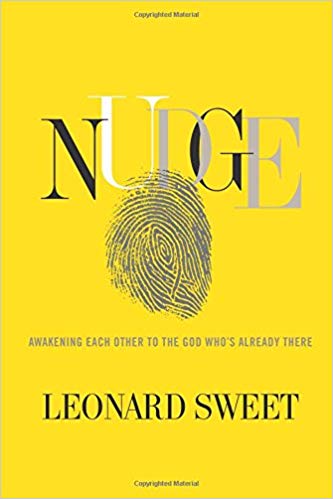Nudge:
Awakening Each Other to the God Who Is Already There
by Leonard Sweet
–Review by Teri Hyrkas
How would you initiate a change in the current negative mindset toward evangelism? Do you think a nudge might help? Nudge: Awakening Each Other To The God Who Is Already There (David. C. Cook, 2010), by author and professor Leonard Sweet, is a perspective-shifting look at what it means for Christians to be faith-sharers in the world today. Starting from the premise that Christians do not bring Christ to the mission field but join God in the work that God has already begun there, Sweet reorients the reader’s attention to show that the practice of evangelism can turn from an anxiety laden toe-to-toe confrontation to a hope filled personal engagement meant to recognize and encourage “Christ in you…”(Col 1:27 NIV).
Sweet, who urgently desires that the Church drop the hit-and-run evangelistic style, suggests that followers of Jesus can be more thoughtful and thorough in their outreach. Rather than employing skirmish-type maneuvers with those who don’t yet know Jesus, Sweet advocates for the use of common sense, as well as the application of all our common senses, to determine where God has gone ahead of us to prepare hearts. It is in these receptive areas of a person’s life that Christ followers can leave a Jesus imprint, says Sweet.
As an initial illustration of nudge evangelism, Sweet draws on his own de-conversion experience. He recounts how a pastor, Reverend Leonard Humbert, kept in touch with him during the several years Sweet spent out of fellowship with Christ. Sweet explains that just as Reverend Humbert remained aware of him, we also can learn to monitor the vital signs of a needy soul — and a hurting world — by using our ears to tune-in, our eyes to assess, our sense of smell to detect conditions, our sense of taste to determine the hunger in body and soul, and our hands to serve. Of Reverend Humbert Sweet says, “[He] didn’t judge me but kept up his gentle nudges to see the God who is already there, wherever I might be.”
Part One of Nudge contains Sweet’s explanation of the term that serves as the subject of the book. Briefly, “to nudge” can be understood as the care-full activity that Christians employ in order to direct others’ attention toward God. But nudging, Sweet writes, is dependent on one’s ability to be a semiotician, or one who “pays attention” to people and things. Because the senses are our primary portals to the act of paying attention, Part One provides an uncommon and helpful look at each of the five common senses: sight, taste, touch, hearing and smelling, and how they can be trained-up and tuned-in to the Spirit’s promptings.
Part Two of Nudge is filled withstories and illustrations which explore various activities that Christians can mix into their lives to practice nudging. These, under the direction of the Holy Spirit, help lead the way to implementing nudge evangelism. The following paragraphs are excerpts from Chapter 2 1/2, “Watch, Witness, and Bear Witness,” and Chapter 4, “Pause: Use Your Ears”:
“The essence of nudge: helping people listen to their lives…. By listening, I’m not talking about listening for flaws, but listening for faith, listening for understanding, listening for Jesus-in-you.(110)
“Nudging is more about learning how to be an ear-witness than an eye-witness. Evangelism is nudging others to see the sacred harmonies. Evangelism is helping people to name what is resonating in them. Again, a good ear-mark to follow is the 10-1 rule: In ten minutes of nudging, nine should go to listening and asking questions and one minute to speaking. But all ten minutes should be seen as a nudge.” (148)
You can probably tell from these excerpts that Nudge is not a typical “how to” book on evangelism. I think Nudge is better described as a “what if?” book or a “holy possibility” resource for sharing Jesus. For those who may not have read any of Leonard Sweet’s books, here is a little nudge to consider: do not expect anything ordinary to appear in these pages. Expect only the extraordinary. There are no dense definitions or empty explanations of evangelism in Nudge. Rather, Nudge is revelatory and unexpected. Prepare to be thoroughly surprised and challenged by the book’s content, and here is one reason why: Sweet is a master of the art of defamiliarization. Sweet himself says, “As a literary device, defamiliarization…was designed as a distancing device to help the reader see something that is deadeningly familiar in a totally new light….By telling something from an oddball perspective that doesn’t fit preconceived notions, by writing elliptically, epigrammatically, the writer skews the view to give a new window on the world.” (233)
The description of the defamiliarization literary style used in his book also serves as an apt illustration for the Nudge evangelistic approach that Sweet is proposing. Are you ready for a fresh outlook on evangelism — one filled with joy rather than fear? What might it mean to employ a type of Christ-sharing that is linked to discipleship, as nudge evangelism is, rather than maintaining a view that evangelism and discipleship are separate entities? In Nudge, Leonard Sweet suggests that if Christians can learn the art of gently nudging others closer to Jesus, then nudge evangelism may indeed provide a new and transfiguring way to see, bring, and be, the Good News in the world. This is the heart of nudge evangelism, and the passion within Nudge: Awakening Each Other To The God Who Is Already There.
.

